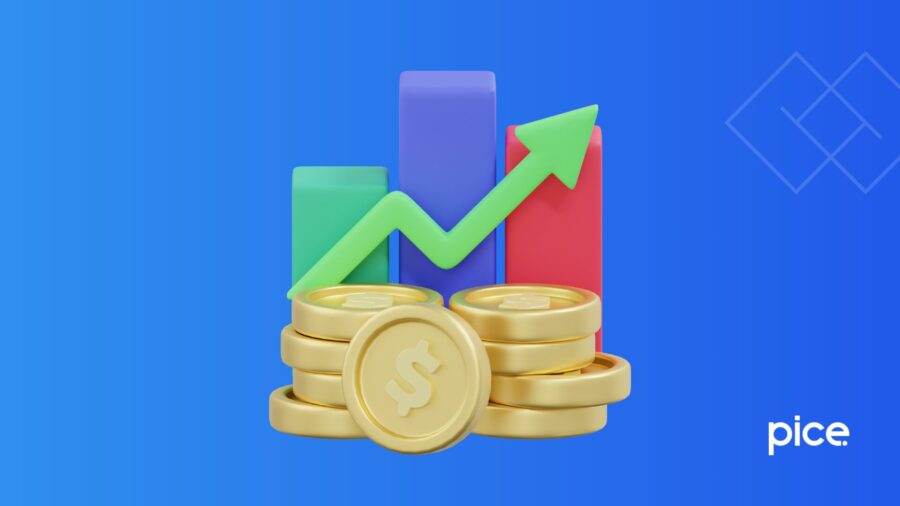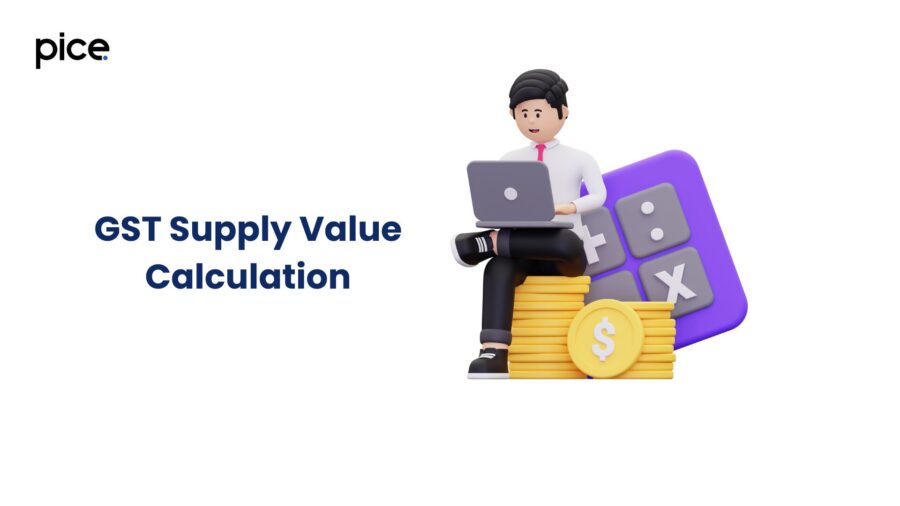Valuation of Supply for GST
- 5 Nov 24
- 9 mins

Valuation of Supply for GST
- What Is Included in the Value of Supply for GST?
- Example of Supply Valuation Under GST
- Importance of Supply Valuation
- How Is Supply Value Calculated?
- Valuation of Supply Using Cost Method
- Valuation of Supply Using Residual Method
- How to Calculate Supply Valuation for GST?
- CGST Rules Related to Supply Valuation
- Conclusion
Key Takeaways
- The value of supply under GST includes additional costs like taxes, duties, and fees, beyond the base price of goods or services.
- Components like incidental costs, recipient-incurred expenses, and penalties for late payments must also be factored into the supply value.
- Different methods—transaction value, comparative, computed, and residual methods—are available for calculating supply value under GST.
- The valuation method depends on specific criteria, such as whether the supply involves related persons, agents, or monetary and non-monetary considerations.
- Accurate supply valuation is crucial for legal compliance, optimizing input tax credits, and ensuring proper financial reporting.
The value of supply under GST can be calculated in multiple ways. Each method varies based on the elements considered in the method. However, additional costs that a supplier incurs to supply goods and services to a recipient need inclusion in the supply value determination. Learn the factors that you need to include in the valuation of supply for GST in this detailed guide.
💡 If you want to pay your GST with Credit Card, then download Pice Business Payment App. Pice is the one stop app for all paying all your business expenses.
What Is Included in the Value of Supply for GST?
The following are the components that need to be included in the value of supply for GST:
Taxes, Duties, Fees, Charges and Cesses
The value of supply needs to include all taxes, cesses, duties and fees other than CGST, SGST, UGST and GST cess.
Amount Spent by the Recipient on the Supplier’s Behalf
The value of taxable supplies needs to include all costs associated with a supply that the supplier has to pay. A supply might include additional costs which need to be included in the value of taxable supply.
Incidental Costs and the Total Sum Charged for Pre-delivery Activities
Here are the incidental expenses that need to be included in the value of supply:
- When a supplier reimburses a commission collected from the recipient for provisions of goods or services, it is a portion of a taxable supply.
- If the invoice received by a supply recipient contains fees for certificates or inspection as additional components, it needs to be included in the value of the supply.
- When a supplier charges a recipient for packaging, there needs to be a deduction of the cost from the supply’s value.
- If a supplier pays transportation and delivery charges for goods supplied to a recipient, the freight charges need to be deducted from the supply value.
Subsidies
Excluding subsidies provided by the Central and State Governments, all other subsidies connected to a supply need inclusion in the supply’s value.
Late Fees for Payments
The value of supply should include interest, late fees and penalties for delayed payment receipts associated with the exchange of goods and services.
Example of Supply Valuation Under GST
Here is an example of supply valuation under GST, considering components like insurance, freight, pre-supply discounts and GST:
| Components | Details |
| Product price | ₹10,000 |
| Add: Insurance | ₹500 |
| Add: Freight | ₹1,000 |
| Less: Pre-supply discount | ₹500 |
| Total transaction value | ₹11,000 |
| Applicable GST rate | 18% |
| GST amount | ₹1,980 |
| Final value of the supply | ₹12,980 |
Importance of Supply Valuation
Here is why supply valuation is important:
- Accurate Tax Calculation: Supply valuation helps charge the accurate amount of GST that a registered taxpayer needs to pay.
- Legal Compliance: Valuation of supply helps taxpayers comply with GST laws while avoiding penalties for delayed tax payments.
- Optimise ITC (Input Tax Credit): Supply value determination helps suppliers claim appropriate input tax credits.
- Pricing Strategy: Supply valuation influences the pricing strategies of suppliers, increasing market competitiveness.
- Transparency: Transparency in financial reporting and transactions is one of the important reasons to undertake supply valuation.
- Financial Planning: With an accurate valuation of supplies, suppliers can perform accurate financial forecasting and planning.
How Is Supply Value Calculated?

The table below illustrates the method of calculating the supply value:
| Method | Description |
| Transaction value | Depends on the actual price paid or payable |
| Comparative method | Value is determined based on supplies under similar conditions |
| Computed value method | Includes the cost of production and profit margin |
| Residual method | Reasonable means consistent with principles and general provisions |
| Inclusion of additional costs | All supply-related charges need to be included in this method |
| Exclusion of GST | Excludes GST components from valuation |
Valuation of Supply Using Cost Method
Here are the components used in calculating supply value with the cost method:
| Component | Description |
| Production cost | Direct and indirect costs incurred to produce goods |
| Profit margin | Reasonable profit margin based on industry standards |
| Add: Overhead expenses | General administrative expenses |
| Add: Distribution costs | Delivery and distribution costs |
| Less: Any discount | Pre-supply discounts |
| Final value of the supply | Sum of all costs and profit margin |
| Applicability | When transaction value cannot be estimated beforehand |
Valuation of Supply Using Residual Method
The following table depicts the supply value calculation with the residual method:
| Component | Description |
| Reasonable means | Calculated using reasonable means consistent with principles |
| Comparison | Includes a comparison between similar supplies |
| Industry standards | Considers industry standards and practices |
| Add: Additional charges | Charges not included in the method |
| Regulatory guidance | Adherence to regulations set by the GST authorities |
| Final value of the supply | Aggregate of all applicable factors |
| Applicability | When it is not feasible to use an alternative method |
How to Calculate Supply Valuation for GST?
Here is how you can calculate supply valuation for GST:
| Step | Description |
| Identification of transaction value | Calculate the price paid or payable |
| Include additional costs | Add taxes, cesses, duties and fees excluding GST and GST cess |
| Deduct discounts | Deduct discounts before the time of supply |
| Add: Supplier’s liability | Add the amount paid by the recipient however incurred by the supplier |
| Apply GST rate | Apply the applicable GST rate |
| Derive the GST amount | Add: GST amount |
| Final value | Derive the total value after adjustments |
CGST Rules Related to Supply Valuation
When it is not possible to assess the supply value under Section 15 as the price is not the sole consideration, the CGST Rules, 2017 apply. Here is how the value of supply needs to be treated:
- Open Market Value: It considers transactions that are entirely monetary, but might not include GST payable for the transaction. This method needs to be applied when the provider and recipient exhibit no relation and the price is the only consideration.
- Supply of Services and Goods of Like Kind and Quality: When there are similarities in quantities, qualities, functional aspects, materials and reputation between goods and services supplied, this method is applicable.
The following are the rules for supply valuation:
Rule 27: When the Consideration Is Not Entirely in Money
The value of supply is
- Open market value
- The complete consideration in money and any additional amount in money which is not equal to consideration in money if the open market value is unavailable
- For the supply of similar goods and services, when it is not possible to determine the value of supply using the above-mentioned criteria
- It includes money and money equivalent to the non-monetary consideration, in addition to a 10% markup.
- Alternative reasonable techniques in accordance with Rule 31
Rule 28: When Supply Is Between Distinct or Related Persons Other than an Agent
When the open market value is unavailable, but the supplier and recipient are related, the following rules apply:
- The supply value of similar goods and services when supplied by an agent
- When the supply value is difficult to determine using the aforesaid criteria, regulations 30 or 31 apply.
- If the recipient supplies goods and services, the supplier can choose to claim 90% of the amount that the recipient charged his/her unaffiliated clients as the value of commodities.
Rule 29: Supply Is Made Through an Agent
If the supply is made through an agent, the following rules apply for supply value determination:
- Open market value of commodities
- The supplier can deduct 90% of the price that the recipient charged him/her for the supply of similar products from his unaffiliated clients.
- However, if the criteria mentioned above are not applicable, regulations 30 or 31 apply.
Rule 30: If you cannot determine the supply value using rules 27, 28 and 29, rule 30 applies. The rule states that the value is 110% of production costs, cost of acquisition or the price of rendering such services. Service providers can, however, implement Rule 30 to consider Rule 31.
Rule 31: When you cannot determine the supply value using Rules 27 to 30, you need to consider Rule 31 and the rules of Section 15 followed by the chapters’ provisions of reasonable methods.
Conclusion
The value of supply under GST can be calculated using the comparative method, computed value method and residual method. A common factor in all the aforesaid methods is the inclusion of additional costs and charges to determine the value of the supply of goods and services.
Ensure you consider the components accurately based on the method of supply value calculation in order to avoid penalties. This will further ensure business compliance with GST rules and regulations.
 By
By 

















